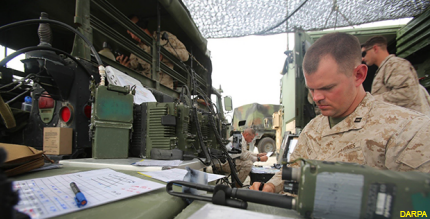Uncluttering the spectrum by putting it on the map
DARPA's RadioMap program, which will give users visibility into the radio spectrum, moves into Phase 3.

Pentagon-backed research is entering the final phase of a program that looks to unclutter the electromagnetic spectrum by allowing users to see how the spectrum is being used in real time.
The RadioMap program—officially called Advanced Radio Mapping—would overlay spectrum information on a map depicting use across frequency, geography and time, allowing users to avoid conflicts in the spectrum while taking the best advantage of what’s available, according to the Defense Advanced Research Projects Agency, which is running the program.
DARPA recently gave Lockheed Martin an $11.8 million contract for Phase 3 of RadioMap, during which the contractor is to build on the work in phases 1 and 2 to develop a working system capable of transitioning to the military services.
Improving spectrum management is a priority for the military, as the growing number of wireless devices and systems—both military and civilian—crowd the airwaves. The Defense Department also is under a mandate to give up 500 MHz of bandwidth for civilian use by 2020. DOD made public its Electromagnetic Spectrum Strategy in February 2014 and in March of this year announced a new collaborative framework on spectrum sharing with the Commerce Department.
Meanwhile, DARPA launched research into gaining better visibility into the radio spectrum itself, through RadioMap and another program, Shared Spectrum Access for Radar and Communications, or SSPARC.
RadioMap is designed not only to make more efficient use of the spectrum, but more efficient use of current devices as well, DARPA said.
“RadioMap adds value to existing radios, jammers and other RF electronic equipment used by our military forces in the field,” said John Chapin, DARPA program manager. “This program doesn’t require purchasing new spectrum-sensing devices. Rather, it uses existing radios and jammers that do double-duty. In the ‘down’ time when they aren’t performing their primary function, the devices sense the spectrum around them and, through RadioMap technology, provide an accurate picture of what frequencies are currently in use and where.”
RadioMap will let operators see where conflicts exist or even anticipate where they might occur, as well as find unused frequencies they can tap to improve the effectiveness of a mission.
During Phase 2 of the program, DARPA conducted successful tests at Quantico Marine Base, and Chapin said the Marines will likely participate in Phase 3. “The Marine Corps is an ideal transition partner for RadioMap,” he said. “They have in place the doctrine, organizational structure, and information systems framework that can effectively integrate RadioMap software.”
DARPA said Phase 3’s base period is set to continue through summer of 2016. If tests then are successful, the program could go live with the Marines after further tests in early 2017.
NEXT STORY: Army awards $662M deal for new recon aircraft



